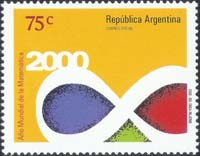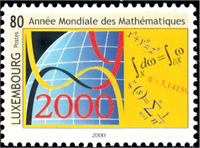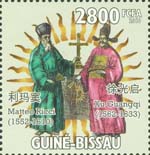MATHINFINITY

Mathematics is the door and key to the sciences ------ Roger Bacon


Mathematics has a long history. Its origins date back from practical human activities such as measuring and trading. In the Rites of Zhou of the Western Zhou Dynasty, mathematics is one of the Six Arts. In the Western world, mathematics originates from Greek, which means learning, study and science. In ancient China, mathematics is called Arithmetic, which refers to the skill of using counting rods. The term Mathematics only appeared in China in the Song and Yuan Dynasties. Nowadays, mathematics is one of the core academic subjects with rich content and of great importance. Mathematics is a language that scientists use in study and their discussion; it is also an indispensable tool in our daily life.
Established in 1874, the Universal Postal Union (UPU) has its headquarters in Berne, Switzerland. It currently has 192 member countries, but the countries and regions that issue stamps are over 200. Stamps are not only an evidence of payment of postage, but it is also a country's name card that shows the customs, technological development, history and culture of the issuing place. People can enrich their knowledge and wisdom from the plentiful knowledge and information contained in the stamp.
Collection of stamps and philatelic products is only a hobby, but also a branch of knowledge. Collectors usually study and collect stamps based on art appreciation, historical values and printing techniques. They may not relate the stamps to a specific subject. We may not notice that a lot of scientific elements are actually included in a stamp, from their appearance to the entire production process. Moreover, a lot of stamps issued by different countries and regions every year are about science and technology. Why don't we combine stamps and mathematics, and learn this fundamental subject again through stamps?
In the Mathinfinity exhibition, we have selected mathematics topics related to our daily life and their corresponding stamps so that visitors can see mathematics from a new different angle. From the original numerals and practical applications, we can brush up our basic knowledge of mathematics and discover the anecdotes through stories and classical allusions. Now, let us begin our fun and interesting journey of mathematics!
Did you know?

- The Nine Chapters on the Mathematical Art of China and Elements of ancient Greece were seen as two major sources of modern mathematics. The initial arrangement and commentary of The Nine Chapters on the Mathematical Art were done by Zhangcang of the Han Dynasty. It does not only refer to land area, exchange of commodities, proportional distribution, consultations on works and taxation, but it is also the first book in the history of mathematics to bring up the System of Linear Equations and explain the applications of Gougu Theorem (known as the Pythagorean Theorem). It was used as a text book in both the Tang and Song Dynasties.
- The ancient Greek mathematician, Euclid, had written the book Elements based on propositions by earlier mathematicians. It covers 23 definitions such as point, line and plane, 5 postulates, 5 axioms and propositions developed from them. The first six books were translated into Chinese by Xu Guangqi of the Ming Dynasty and the Italian Jesuit, Matteo Ricci. The last nine books were translated by the Chinese mathematician of the Qing Dynasty, Li Shanlan, and the British missionary, Alexander Wylie. It became a text book for secondary students during the 19th century.
About CMM
Contact US
Others
Other Websites
Number of Visitors:
Last Modified Date: 10/03/2025